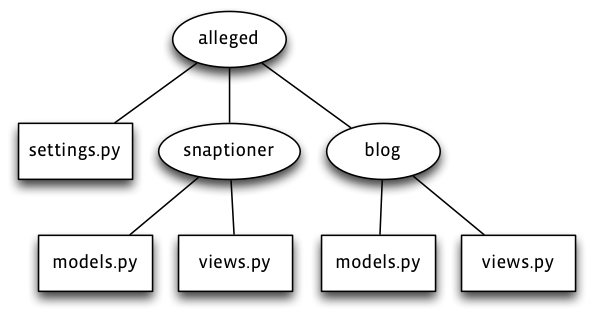Django 1.4 introduces two big changes that require thinking about: (1) support for time zones, (2) removing some magic about where app modules go on disk. This is as good a time as any to update the layout of my Django projects.
I wrote these notes for my own reference when rearranging some of my existing sites. This is just one possible prohect layout. It is mostly convenient when your apps are expected to be one-offs: it has the benefit of a shallower directory structure.
Less-magical Path Entails New Layout
In 1.3, your project was in a directory alleged, which is the current
working directory while you are working on the site.

But in settngs.py the
app in the subdirectory blog is imported as alleged.blog, so some path
mungery is required to add the parent directory of the directory with
settings.py to your path. In 1.4 this bit of magic goes away.
Amongst other things this means a new manage.py file.
For tidiness (following the suggestion on the Django site; I am not sure it is required as such) you can create a new subdirectory for the site files themselves.
mkdir allegedsite
git mv settings-sample.py urls.py allegedsite
mv settings.py allegedsite
git mv urls.py allegedsite
touch allegedsite/__init__.py
In settings.py, remove alleged. from the names of apps, so they are all
relative to the project directory. Where we had the following:
INSTALLED_APPS = (
…
'alleged.snaptioner',
'alleged.blog',
)
we now have this:
INSTALLED_APPS = (
…
'snaptioner',
'blog',
)
Another thing to check is use of tricks like the following:
def expand_path(partial_path):
return os.path.join(os.path.dirname(__file__), partial_path)
…
SNAPTIONER_LIBRARY_DIR = expand_path('albums')
Either move these directories in to the site directory or edit these settings to add a ../.
Because the site files are now in allegedsite, you also need to change this line in settings.py from this:
ROOT_URLCONF = 'alleged.urls'
to this:
ROOT_URLCONF = 'allegedsite.urls'
Similarly in several of the Python files we need to change things like this import line:
from alleged.fromatom import get_flickr, get_livejournal, get_youtube
To this:
from blog.fromatom import get_flickr, get_livejournal, get_youtube
Static Files
The staticfiles app removes the need for a lot of hackery and custom code in Django apps. To use it we must do some simple steps:
First, In settings.py, add django.contrib.staticfiles to INSTALLED_APPS.
Second, create static subdirectories in apps and move static content in to the appropriate apps. For example:
mkdir blog/static
git mv static/js/ blog/static/
Third, replace whatever tag was used to generate the static directory with a call to the static tag. For example, changing
<script src="{{ settings.STATIC_URL }js/snaptioner.js" %}"
type="text/javascript"></script>
with this:
<script src="{% static "js/snaptioner.js" %}" type="text/javascript"></script>
Each affected template will also need the line
{% load staticfiles %}
added near the top.
By default this just prefixes the URL reference with the STATIC_URL value, but a fancier static-files handler might do something more complex with it.
Fourth, set up the directory static files are copied to. In my old setup I
exploited the old Mac OS X convention with static sites in ~/Sites: by
creating a symbollic link linking ~/Sites/alleged to
~/Projects/alleged/static I got the built-in Apache server to serve the
projects copy of the static files. Now I have deleted the symlink and replaced
it with a directory, and edited settings.py to add
STATIC_ROOT = '/Users/pdc/Sites/alleged'
Now running
./manage.py collectstatic --noinput
Copies the static files to the static server.
For the development settings, a simpler alternative would be to remove the
static server altogether and leave STATIC_ROOT and STATIC_URL out of
settings.py. The development server will then take charge of serving the
static files itself.
TEMPLATE_CONTEXT_PROCESSORS Setting
If we have added context processors then this setting needs updating because
(1) there is a new processor for handling time zones, and (2) the auth
processor has changed its module name. The new defaults are described on the
settings page.
In most cases with my sites the only non-standard context processor I had was one to pass the static-files URL in to templates; this is no longer needed because of the static files support, which means it is possible to delete the setting altogether and use the default.
Timezone Support
I don‘t actually have much to add beyond the Support for time zones section of the release notes, except that I discovered that time zones and PyPy do not mix – at least PyPy 1.8 had a bug that manifested when trying to run tests involving timezone-savvy dates.
WSGI Support
This allows easier deployment on WSGI-savvy web servers (such as Nginx+uWSGI or Gunicorn). To use it you need to add the file that would have been added by the django startproject command as described on the WSGI deployment page.